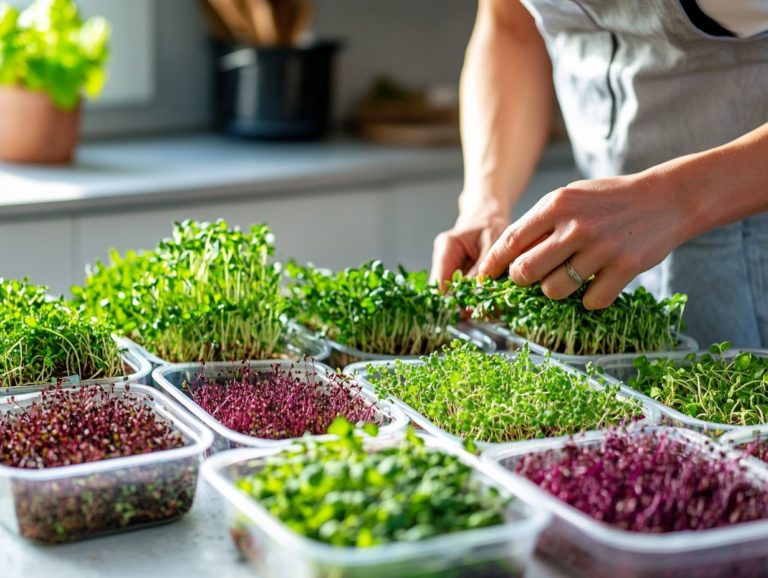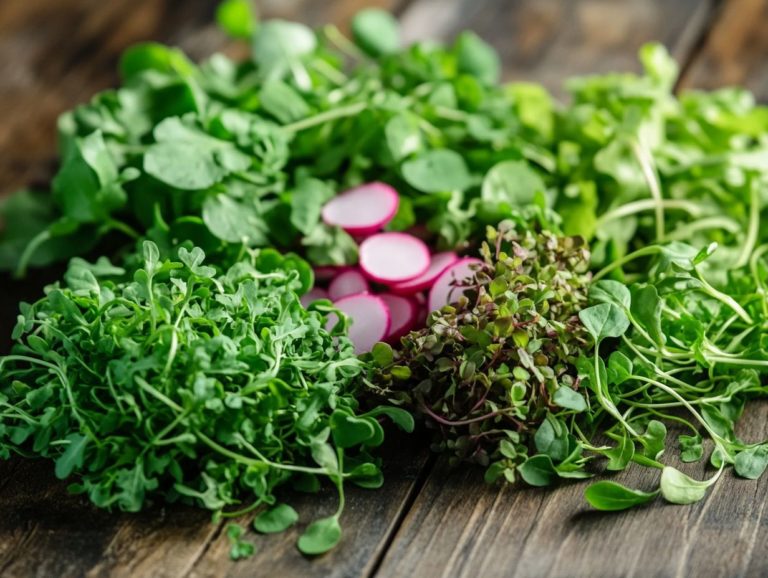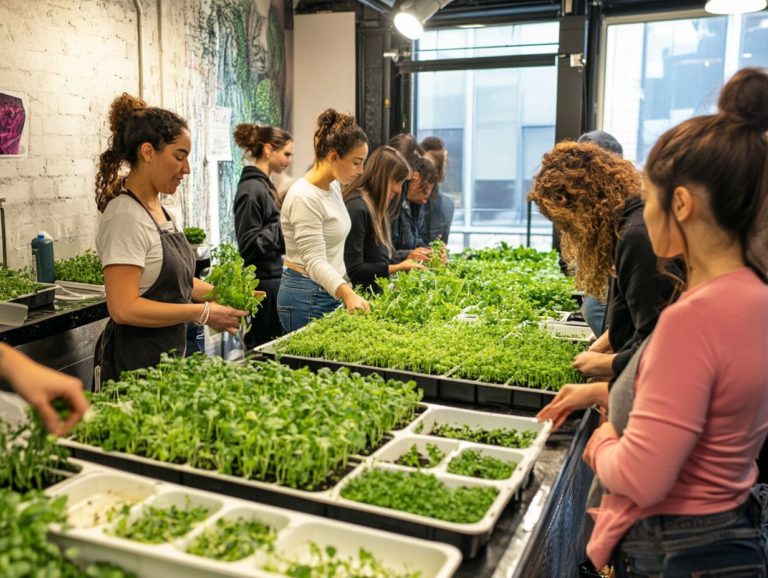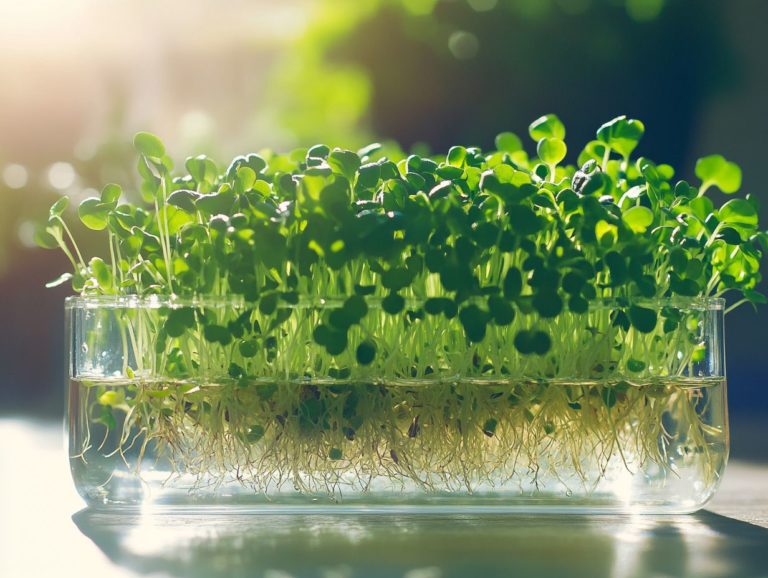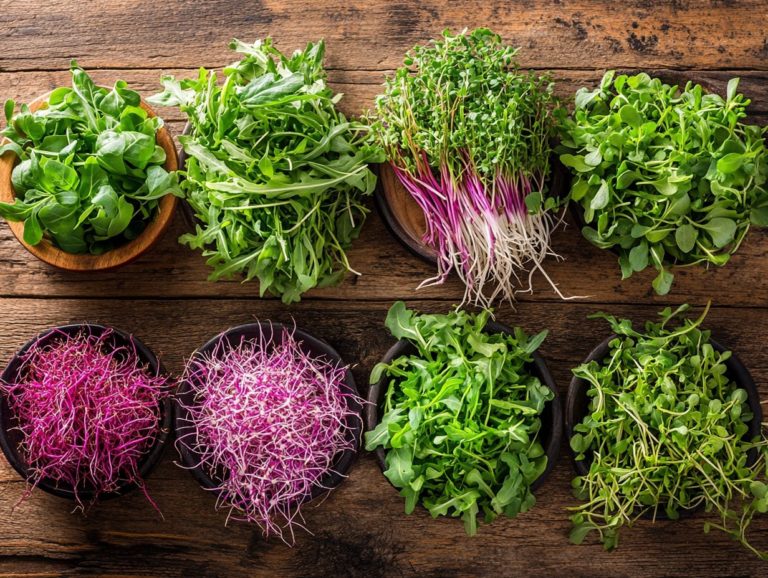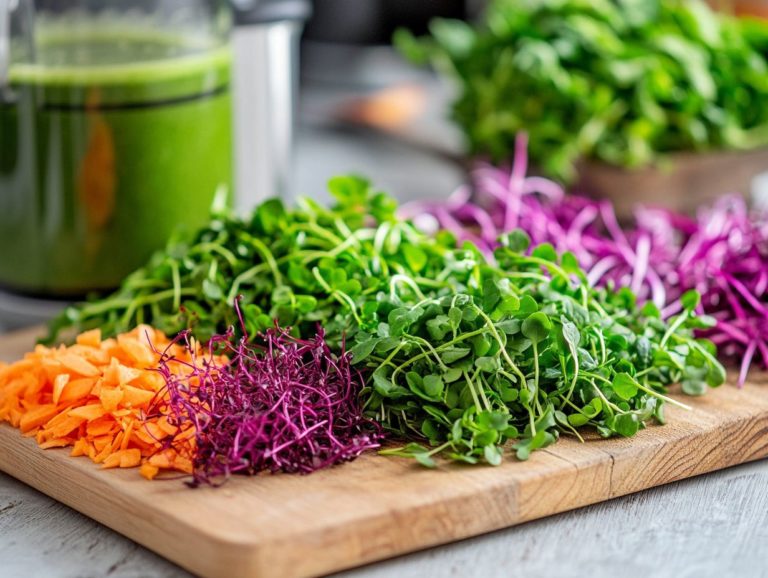What Is the Best Temperature for Microgreens?
Microgreens are tiny powerhouses of flavor and nutrition that can elevate your culinary creations while boosting your health. As their popularity surges among home gardeners and chefs alike, mastering the art of growing them successfully becomes essential.
This article delves into the myriad advantages of cultivating microgreens, highlighting their remarkable nutritional value and unparalleled convenience. You ll discover the key factors that influence their growth, with a particular focus on optimal temperature.
By understanding how to maintain the right conditions and sidestep common pitfalls, you can cultivate a thriving microgreen garden that enhances both your meals and your well-being.
Contents
- Key Takeaways:
- Benefits of Growing Microgreens
- Factors that Affect Microgreen Growth
- Optimal Temperature for Microgreens
- How to Maintain the Right Temperature
- Common Mistakes in Temperature Management
- Frequently Asked Questions
- What Is the Best Temperature for Microgreens?
- Why is the temperature important for growing microgreens?
- Can microgreens tolerate cold temperatures?
- What happens if microgreens are grown in high temperatures?
- How can I maintain the ideal temperature for my microgreens?
- Are there specific temperature requirements for different types of microgreens?
Key Takeaways:
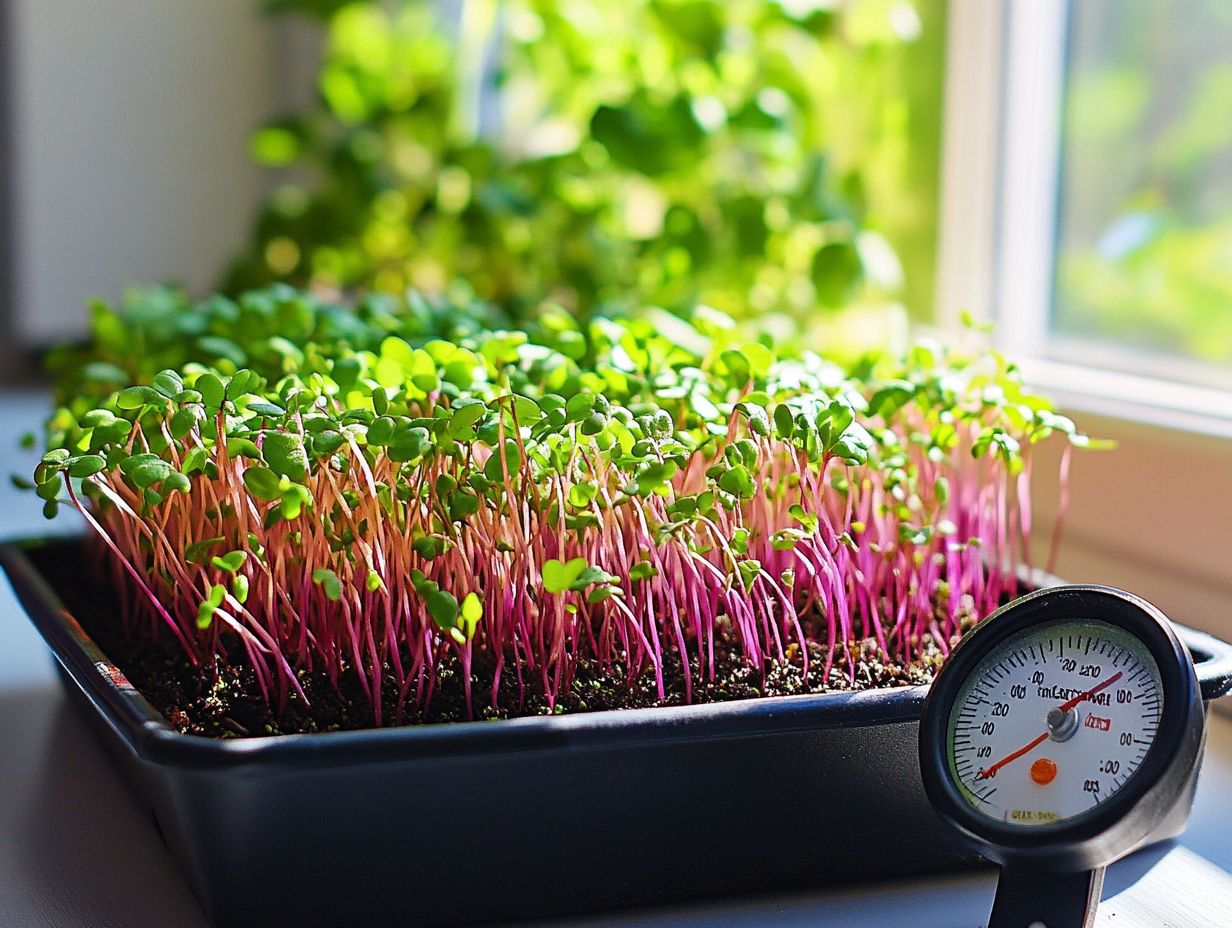
- The best temperature for microgreens falls within a recommended range of 60-70 F (15-21 C).
- Maintaining the right temperature is key for successful microgreen growth.
- Factors such as light, water, and temperature all play a crucial role in the growth of microgreens, making it important to carefully monitor and control these elements.
What are Microgreens?
Microgreens are the young, edible seedlings of vegetables and herbs, typically harvested just after those first true leaves emerge. This makes them a favored choice among home gardeners and chefs who appreciate their versatility.
These delicate greens not only introduce a vibrant splash of color to your dishes but also deliver a robust flavor and essential nutrients, perfect for enhancing salads, garnishes, and sandwiches.
Some popular varieties you might consider include:
- Radish
- Arugula
- Sunflower
Each variety boasts its own distinct tastes and health benefits. With innovative growing systems like Hamama, cultivating microgreens has never been simpler. They utilize unique seed quilts, which are pre-seeded mats that simplify the planting process, and specially formulated potting mixes to optimize growth, ensuring even novice gardeners can cultivate a flourishing indoor or outdoor garden.
This approach underscores the convenience of microgreens, allowing you to effortlessly incorporate fresh, homegrown ingredients into your culinary creations.
Benefits of Growing Microgreens
Growing microgreens offers a wealth of benefits, enhancing both your personal health and culinary adventures, making them an invaluable addition to your garden or kitchen.
These vibrant little plants are not just quick to grow; they are also loaded with essential vitamins and minerals. This transforms them into a nutritional powerhouse. Their straightforward growing process means even novice gardeners can revel in the delight of nurturing healthy, flavorful plants, all while enjoying the rewards of fresh produce right at home.
Nutritional Value and Convenience
Microgreens present exceptional nutritional value, often boasting higher concentrations of vitamins and minerals compared to their mature counterparts. For those who prioritize health, these tiny powerhouses are an ideal choice.
Their vibrant profiles can include antioxidants and essential vitamins A, C, E, and K, all of which support various bodily functions and contribute to overall wellness, aiding in disease prevention.
The beauty of growing microgreens is their convenience they thrive indoors, utilizing energy-efficient LED lights or on a balcony, enhancing both flavor and health in your everyday meals.
These young plants are remarkably adaptable, flourishing in a variety of conditions while requiring minimal space and time to grow. To optimize their growth, you’ll want to maintain humidity levels between 40-70% and provide ample light exposure ideally 12-16 hours each day, whether that s from natural sunlight or LED lights.
Popular options like broccoli, radish, and sunflower microgreens not only add unique flavors but also deliver distinct health benefits, including anti-inflammatory properties and improved digestion.
Incorporating microgreens into your daily diet elevates your culinary creations while fortifying your nutritional intake. This makes them a savvy choice for both seasoned gardeners and those just starting on their gardening journey.
Start your microgreen garden today to enjoy fresh flavors and boost your health quickly!
Factors that Affect Microgreen Growth
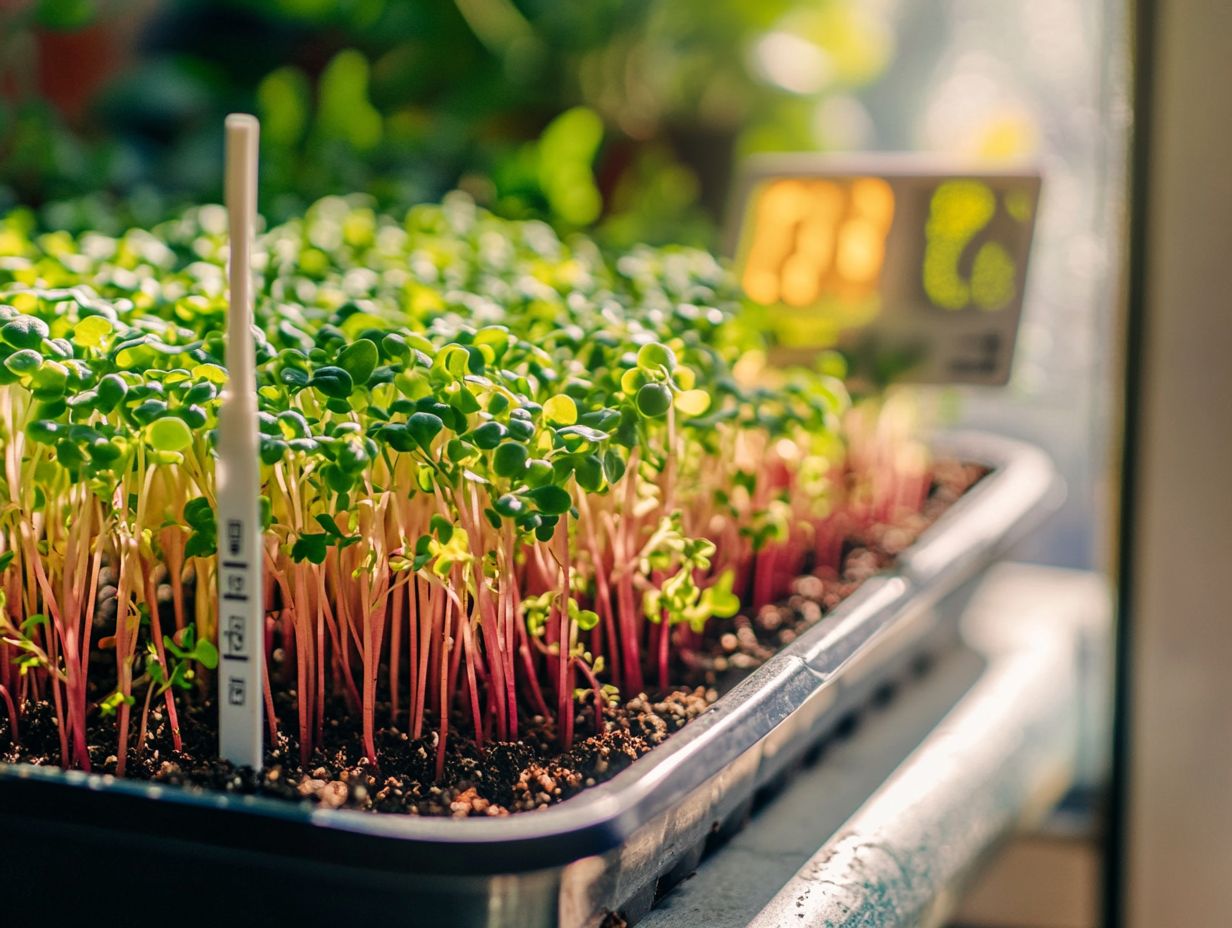
Several key factors play a pivotal role in the growth of microgreens. These include environmental conditions such as humidity levels, temperature control, soil moisture, and light exposure.
Grasping these variables is essential for successfully cultivating microgreens like Sunflower and Buckwheat. Understanding them helps you optimize your growing conditions for maximum yield and health benefits!
Proper management of humidity and maintaining the right temperature range can significantly impact germination rates and overall plant health. This makes these considerations vital for anyone serious about growing microgreens effectively.
Utilizing seedling trays can also aid in achieving consistent growth.
Light, Water, and Temperature
Light, water, and temperature are key elements that significantly influence the growth and development of microgreens. Managing these factors effectively is crucial for achieving consistent growth.
You can create an ideal environment for your plants by utilizing tools like humidity trays to maintain moisture levels and heating mats to regulate warmth. For instance, basil microgreens thrive at around 70 F and require moderate light, while radish microgreens prefer a cooler range of 60 F to 65 F and flourish under bright, indirect sunlight.
Using a moisture meter allows you to gauge the right amount of water, ensuring your seedlings don t drown or dry out. By implementing these techniques, you can cater to the unique preferences of different varieties, ultimately leading to vibrant and healthy microgreens!
Optimal Temperature for Microgreens
Maintaining the perfect temperature for your microgreens is essential for their growth and overall health. The ideal range can vary depending on the seed variety you choose.
Generally, microgreens thrive best between 70 F and 75 F. This range promotes rapid germination and vibrant plant development. Additionally, understanding what’s the ideal pH level for microgreens can help you craft an environment that closely resembles these conditions, allowing you to significantly boost both the yield and quality of your harvest!
Recommended Temperature Range
The ideal temperature range for growing microgreens typically hovers between 65 F and 75 F. This sweet spot supports optimal growth for various seed varieties, including Broccoli and Sunflower.
This temperature range fosters healthy seedling development while keeping problems like excess moisture and heat stress at bay. Understanding these specific needs helps you achieve more uniform growth and cultivate healthier plants.
For example, Pea shoots thrive best at slightly cooler temperatures around 60 F to 70 F. In contrast, Radish microgreens prefer the warmer side of the spectrum. Additionally, knowing what soil is best for microgreens can further enhance your growing results. By tailoring these environments, whether indoors or outdoors, you can optimize conditions for each type.
Utilizing thermometers and hygrometers will become your best friends for monitoring. Additionally, simple adjustments like using fans or heat mats can help maintain those ideal temperatures.
Placing your trays in locations that receive indirect sunlight can also aid in temperature regulation. This ensures your microgreens grow healthy and robust, packed with enhanced flavor and nutrient density.
Regularly checking water levels is crucial for maintaining optimal potting mix moisture.
How to Maintain the Right Temperature
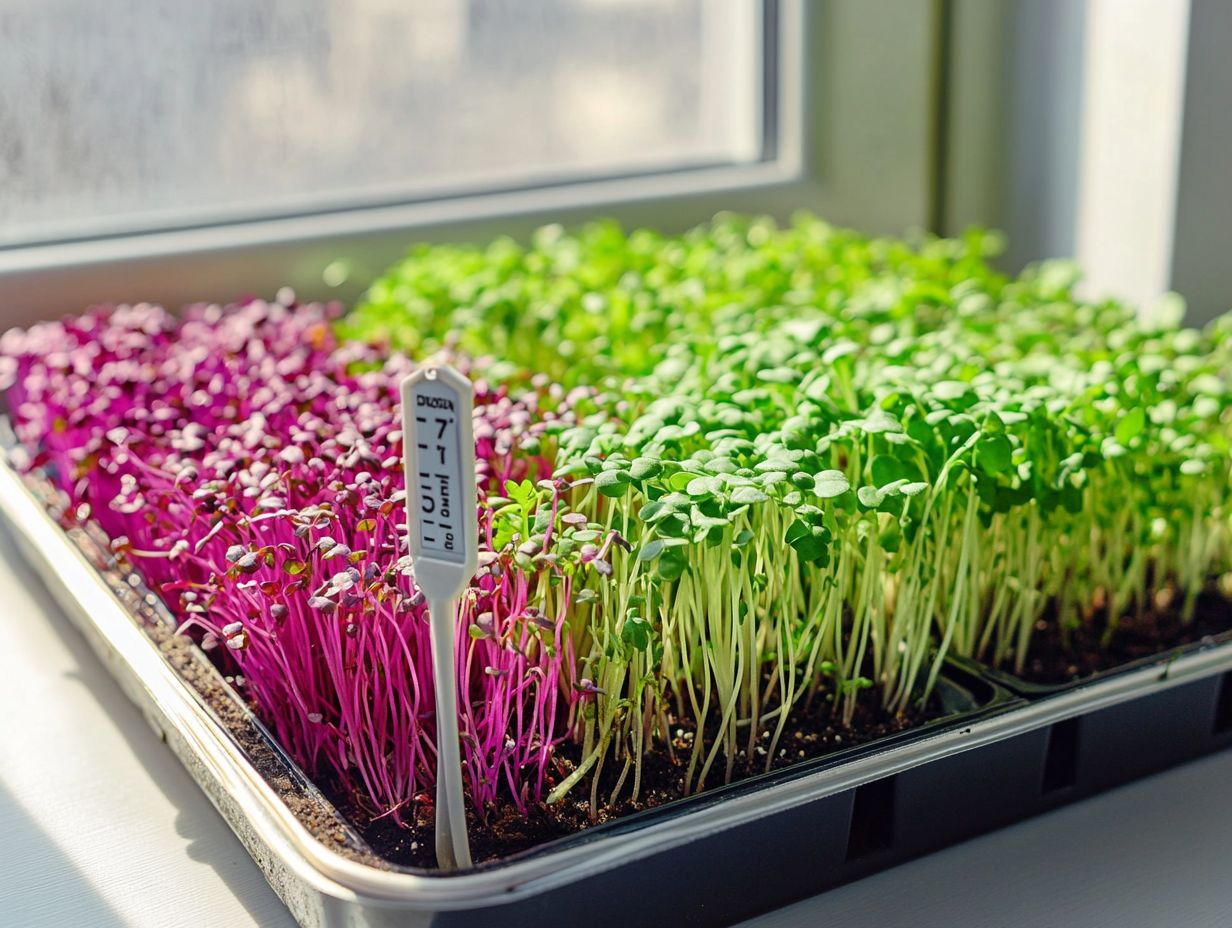
Maintaining the ideal temperature for microgreens is essential for achieving consistent growth and successful cultivation. You can accomplish this through various techniques tailored to your specific climate conditions.
Using tools like heating mats and humidity trays effectively regulates both temperature and moisture levels. This creates the perfect environment for your microgreens!
Also, proper watering techniques are vital. They help you avoid excess moisture, crucial for preventing the overwatering of seeds and promoting healthy root systems that enhance water uptake.
Controlling Temperature in Different Environments
Controlling temperature in various environments is vital for your success in growing microgreens, whether you’re growing them inside or outside. If you’re tending to indoor plants, investing in proper lighting and temperature control systems will help you create the ideal conditions.
For outdoor growers, adapting to the ever-changing climate is key. By mastering how to manipulate these factors, you ll keep your microgreens healthy and vibrant throughout their growth cycle.
Try using innovative techniques like smart thermostats (devices that automatically adjust the temperature) and automated systems to enhance your indoor gardening efficiency. If you re managing outdoor plots, using shade cloths or row covers can help alleviate heat stress during scorching days. Meanwhile, frost blankets offer protection for delicate seedlings against unexpected nighttime chills, thus ensuring better seedling development.
Don t overlook natural ventilation methods like strategically placed fans or open windows. These can significantly improve air circulation and temperature regulation indoors. By blending modern technology with timeless gardening wisdom, you ll ensure your microgreens thrive, adapting effortlessly to the whims of nature and the unique challenges your growing environment presents.
Common Mistakes in Temperature Management
Common mistakes in temperature management can lead to significant issues, such as overwatering seeds, excess moisture, or inconsistent growth. These issues can impede your microgreen cultivation success.
Many growers tend to underestimate the importance of maintaining proper humidity levels and temperature ranges. This often results in stunted seedling development and diminished yields. Recognizing these pitfalls is crucial for anyone aiming to cultivate healthy and vibrant microgreens effectively.
Avoiding Pitfalls for Successful Growth
Avoiding pitfalls in temperature and humidity management is essential for your success in growing microgreens. When conditions are off, you risk stunted growth and disease definitely not the outcome you re aiming for.
By mastering the art of monitoring and adjusting factors like humidity levels and water uptake, you can cultivate the ideal environment for your microgreens to flourish. Implementing best practices sets your microgreens up for a thriving, bountiful harvest!
One effective strategy is to invest in a dependable thermometer (a tool that measures temperature) and hygrometer (a tool that measures humidity), allowing you to keep a constant eye on your growing environment.
Aim for ideal temperature ranges between 65 F and 75 F, with humidity levels around 40-60%. Consider using fans or ventilation systems to enhance air circulation; this can help reduce excess moisture and fend off fungal problems.
Adjusting your watering schedule based on the season is a smart way to maintain the perfect moisture balance. Regularly checking for signs of plant stress enables you to make quick adjustments, ensuring your microgreens stay healthy and productive.
Frequently Asked Questions
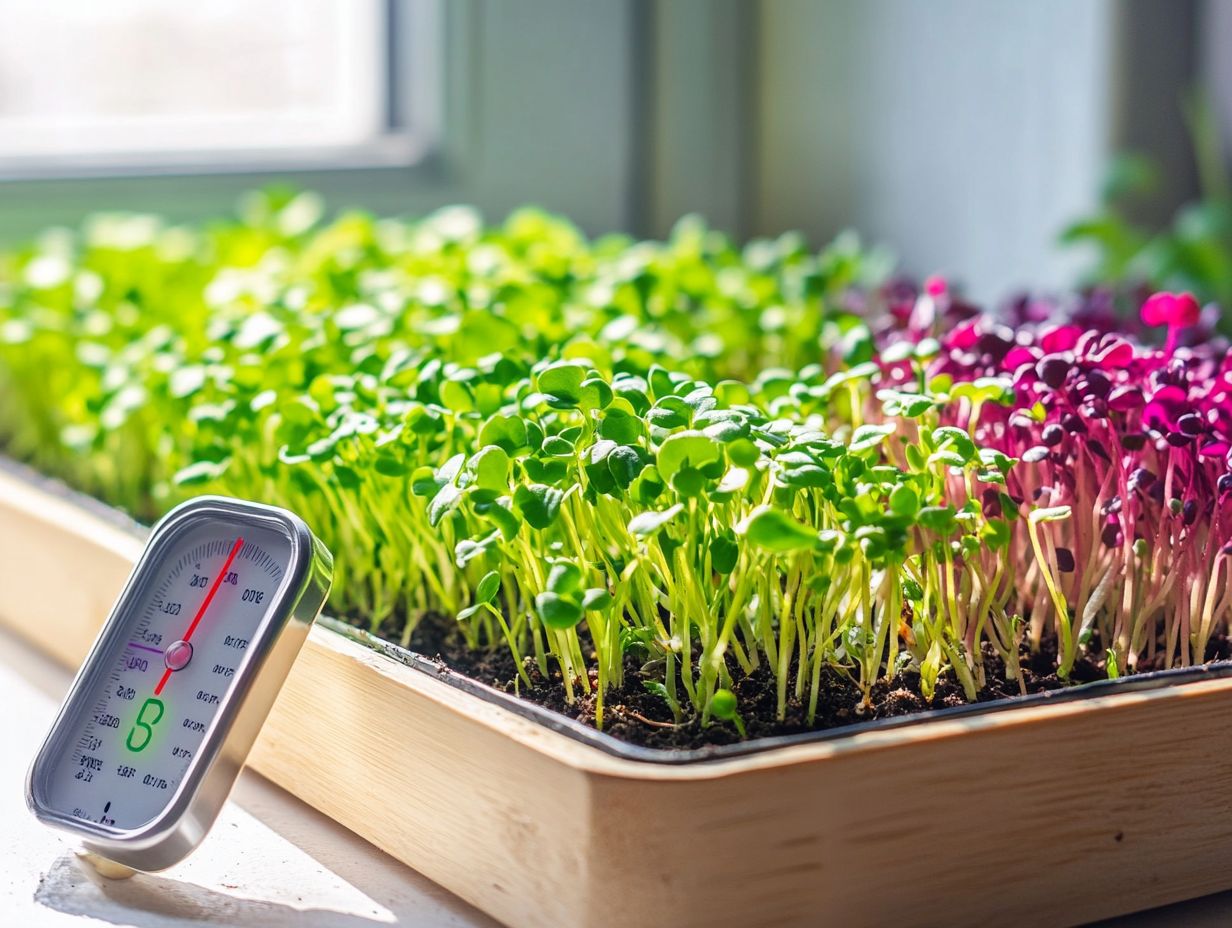
What Is the Best Temperature for Microgreens?
The best temperature for microgreens is between 65-75 F (18-24 C).
Why is the temperature important for growing microgreens?
Temperature plays a crucial role in the growth and development of microgreens, affecting their growth rate, color, taste, and overall quality.
Can microgreens tolerate cold temperatures?
Microgreens are more sensitive to cold temperatures compared to mature plants. It is important to keep them in a warm and controlled environment for optimal growth.
What happens if microgreens are grown in high temperatures?
High temperatures can cause microgreens to wilt, dry out, and become bitter or tough in taste. They may also develop fungal or bacterial diseases.
How can I maintain the ideal temperature for my microgreens?
Using a thermometer, you can monitor the temperature in your growing area and make adjustments as needed. You can also use a heating mat or grow lights to maintain the optimal temperature.
Start your microgreens journey today and share your experiences with others!
Are there specific temperature requirements for different types of microgreens?
Yes, different microgreens thrive in specific temperature ranges. Broccoli microgreens prefer cooler temperatures, around 60-65 F (15-18 C).
On the other hand, sunflower microgreens enjoy warmer conditions, thriving between 70-75 F (21-24 C).
Knowing these preferences can help you grow healthier microgreens!

